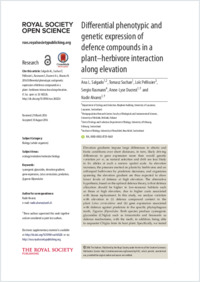Differential phenotypic and genetic expression of defence compounds in a plant–herbivore interaction along elevation
- Salgado, Ana L. Department of Ecology and Evolution, Biophore building, University of Lausanne, Switzerland - Metapopulation Research Centre, Faculty of Biological and Environmental Sciences, University of Helsinki, Finland
- Suchan, Tomasz Department of Ecology and Evolution, Biophore building, University of Lausanne, Switzerland
- Pellissier, Loïc Unit of Ecology and Evolution, Department of Biology, University of Fribourg, Switzerland
- Rasmann, Sergio Institute of Biology, University of Neuchâtel, Switzerland
- Ducrest, Anne-Lyse Department of Ecology and Evolution, Biophore building, University of Lausanne, Switzerland
- Alvarez, Nadir Department of Ecology and Evolution, Biophore building, University of Lausanne, Switzerland
-
01.09.2016
Published in:
- Royal Society Open Science. - 2016, vol. 3, no. 9, p. 160226
cyanogenic glycosides
elevation gradient
gene expression
Lotus corniculatus
predation
Zygaena filipendulae
English
Elevation gradients impose large differences in abiotic and biotic conditions over short distances, in turn, likely driving differences in gene expression more than would genetic variation per se, as natural selection and drift are less likely to fix alleles at such a narrow spatial scale. As elevation increases, the pressure exerted on plants by herbivores and on arthropod herbivores by predators decreases, and organisms spanning the elevation gradient are thus expected to show lower levels of defence at high elevation. The alternative hypothesis, based on the optimal defence theory, is that defence allocation should be higher in low-resource habitats such as those at high elevation, due to higher costs associated with tissue replacement. In this study, we analyse variation with elevation in (i) defence compound content in the plant Lotus corniculatus and (ii) gene expression associated with defence against predators in the specific phytophagous moth, Zygaena filipendulae. Both species produce cyanogenic glycosides (CNglcs) such as lotaustralin and linamarin as defence mechanisms, with the moth, in addition, being able to sequester CNglcs from its host plant. Specifically, we tested the assumption that the defence-associated phenotype in plants and the gene expression in the insect herbivore should covary between low- and high- elevation environments. We found that L. corniculatus accumulated more CNglcs at high elevation, a result in agreement with the optimal defence theory. By contrast, we found that the levels of expression in the defence genes of Z. filipendulae larvae were not related to the CNglc content of their host plant. Overall, expression levels were not correlated with elevation either, with the exception of the UGT33A1 gene, which showed a marginally significant trend towards higher expression at high elevation when using a simple statistical framework. These results suggest that the defence phenotype of plants against herbivores, and subsequent herbivore sequestration machineries and de novo production, are based on a complex network of interactions.
- Faculty
- Faculté des sciences et de médecine
- Department
- Département de Biologie
- Language
-
- English
- Classification
- Biological sciences
- License
-
License undefined
- Identifiers
-
- RERO DOC 278432
- DOI 10.1098/rsos.160226
- Persistent URL
- https://folia.unifr.ch/unifr/documents/305178
Statistics
Document views: 136
File downloads:
- pdf: 163
